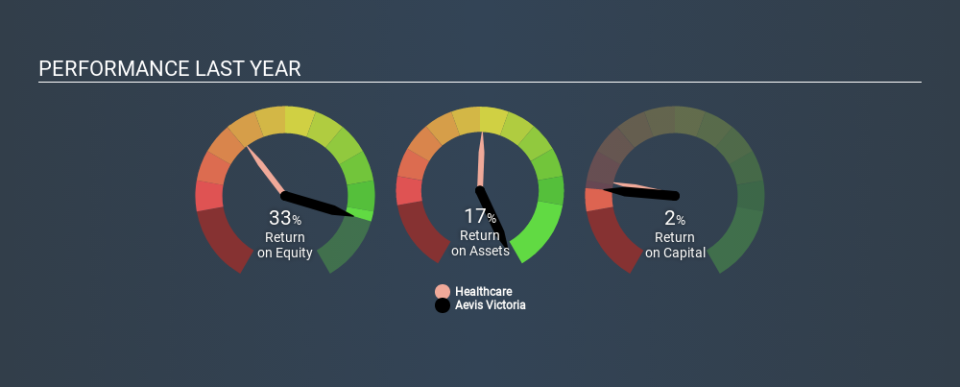Is Aevis Victoria SA (VTX:AEVS) Struggling With Its 1.8% Return On Capital Employed?

Today we'll look at Aevis Victoria SA (VTX:AEVS) and reflect on its potential as an investment. To be precise, we'll consider its Return On Capital Employed (ROCE), as that will inform our view of the quality of the business.
First of all, we'll work out how to calculate ROCE. Next, we'll compare it to others in its industry. Then we'll determine how its current liabilities are affecting its ROCE.
Return On Capital Employed (ROCE): What is it?
ROCE is a measure of a company's yearly pre-tax profit (its return), relative to the capital employed in the business. All else being equal, a better business will have a higher ROCE. In brief, it is a useful tool, but it is not without drawbacks. Renowned investment researcher Michael Mauboussin has suggested that a high ROCE can indicate that 'one dollar invested in the company generates value of more than one dollar'.
How Do You Calculate Return On Capital Employed?
Analysts use this formula to calculate return on capital employed:
Return on Capital Employed = Earnings Before Interest and Tax (EBIT) ÷ (Total Assets - Current Liabilities)
Or for Aevis Victoria:
0.018 = CHF18m ÷ (CHF1.2b - CHF231m) (Based on the trailing twelve months to June 2019.)
So, Aevis Victoria has an ROCE of 1.8%.
See our latest analysis for Aevis Victoria
Does Aevis Victoria Have A Good ROCE?
ROCE can be useful when making comparisons, such as between similar companies. Using our data, Aevis Victoria's ROCE appears to be significantly below the 7.4% average in the Healthcare industry. This could be seen as a negative, as it suggests some competitors may be employing their capital more efficiently. Regardless of how Aevis Victoria stacks up against its industry, its ROCE in absolute terms is quite low (especially compared to a bank account). Readers may wish to look for more rewarding investments.
We can see that, Aevis Victoria currently has an ROCE of 1.8%, less than the 2.7% it reported 3 years ago. So investors might consider if it has had issues recently. You can click on the image below to see (in greater detail) how Aevis Victoria's past growth compares to other companies.
Remember that this metric is backwards looking - it shows what has happened in the past, and does not accurately predict the future. Companies in cyclical industries can be difficult to understand using ROCE, as returns typically look high during boom times, and low during busts. ROCE is only a point-in-time measure. If Aevis Victoria is cyclical, it could make sense to check out this free graph of past earnings, revenue and cash flow.
How Aevis Victoria's Current Liabilities Impact Its ROCE
Current liabilities are short term bills and invoices that need to be paid in 12 months or less. The ROCE equation subtracts current liabilities from capital employed, so a company with a lot of current liabilities appears to have less capital employed, and a higher ROCE than otherwise. To check the impact of this, we calculate if a company has high current liabilities relative to its total assets.
Aevis Victoria has total liabilities of CHF231m and total assets of CHF1.2b. As a result, its current liabilities are equal to approximately 19% of its total assets. This is a modest level of current liabilities, which will have a limited impact on the ROCE.
What We Can Learn From Aevis Victoria's ROCE
While that is good to see, Aevis Victoria has a low ROCE and does not look attractive in this analysis. Of course, you might find a fantastic investment by looking at a few good candidates. So take a peek at this free list of companies with modest (or no) debt, trading on a P/E below 20.
I will like Aevis Victoria better if I see some big insider buys. While we wait, check out this free list of growing companies with considerable, recent, insider buying.
If you spot an error that warrants correction, please contact the editor at editorial-team@simplywallst.com. This article by Simply Wall St is general in nature. It does not constitute a recommendation to buy or sell any stock, and does not take account of your objectives, or your financial situation. Simply Wall St has no position in the stocks mentioned.
We aim to bring you long-term focused research analysis driven by fundamental data. Note that our analysis may not factor in the latest price-sensitive company announcements or qualitative material. Thank you for reading.

